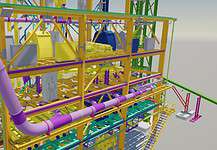Friday, June 19 2015
LAST year, Rio Tinto sold a rare 1.21 carat Fancy Red diamond from its Argyle mine in WA’s remote East Kimberley for a record price. Although the company wouldn’t disclose just how much the stone sold for, it did state that the collection of 54 pink and red diamonds achieved the highest price per carat since the yearly tender process began 30 years ago.
In that time, Argyle Diamonds has earned a strong reputation as the world’s only reliable source of pink diamonds – and while the pink and even rarer red diamonds make up only a small percentage of the mine’s production, Argyle has become synonymous with rare and illustrious gems – producing about 90 per cent of the world’s pink and red diamonds.
Fancy Reds are regarded as the rarest in the world and seldom cost less than $100,000 for a diamond above 0.2 carat. Argyle has only offered 13 fancy red diamonds in its previous tenders, with only three of those gems weighing in at more than 1 carat.
Since it was commissioned, Argyle has produced more than 800 million carats of rough diamonds, the majority of which are white or champagne coloured. Each year, Rio Tinto sells its diamonds via tender, in what has become one of the most important events on the diamond market calendar.
The company’s most recent tender in October 2014, a special 30th anniversary collection of pink and red diamonds, met with more than 600 bids from 10 countries.
“We are delighted with this result which reflects the global appeal and enduring value for these increasingly rare and iconic gems,” Rio Tinto Diamonds managing director Jean-Marc Lieberherr said.
The company stated that overall prices for its signature pink diamonds had more than tripled in the last 15 years.
Going underground
From 1983 the Argyle diamond deposit, in the AK1 pipe, was mined using conventional alluvial and open pit mining. In 2013 the operation moved underground in order to access the pipe at further depth.
The US$2.2 billion underground expansion increased the mine’s life to at least 2020 at a capacity of 11 million tonnes of ore per annum.
Argyle is the first WA mine to use block caving technology, and one of only a handful Australia-wide.
“The decision to construct a block cave mine followed extensive studies into the safest and most economic way to reach deep into Argyle’s ore body,” Rio Tinto stated.
Block caving involves undercutting the ore and allowing it to cave under its own weight. At Argyle, diamond-bearing ore falls through a series of cone-shaped funnels after being broken up by explosives.
The Argyle underground operation comprises about 40km of tunnels – two for vehicles, one for ventilation, 16 for production and one for moving ore – and 273 draw points to access the ore.
According to Rio, the operation is one of the most automated in the world. Driverless 14t loaders, operated from the surface, transport the ore between the draw points and two crushers installed in chambers deep underground.
The crushed ore is then carried 2.2km by underground conveyor belt to the surface.
The majority of the diamonds from Argyle are sold as uncut or ‘rough’ diamonds through the company’s marketing team in Antwerp, Belgium. The majority of customers for the rough product are Indian based companies. According to Rio Tinto, the Indian cutting industry has been an important platform for developing the market for small, coloured diamonds that characterise Argyle production.
Pink diamonds from the mine are retained for cutting and polishing and then sold to an international customer base comprising traders, jewellery manufacturers, jewellery designers and luxury retailers. The best from each year are cut and polished in WA and sold through the annual tender.
Production
According to Rio Tinto’s annual report, production in 2014 was substantially lower, dropping from 11 million carats in 2013 to 9 million carats in 2014.
“Argyle production was negatively impacted by the move from open pit to underground mining, the processing of lower grade tailings as underground production ramped up, and a maintenance shutdown impacting both underground crushers,” the company stated.
“The second crusher at Argyle was commissioned during the year and the ramp-up of the Argyle underground mine to full operation is on schedule to be completed by 2015.”
Production began to turn around in the first quarter of 2015, reaching 3.2 million carats compared to 2.46 million carats for the same period in 2014 and 1.83 million carats for the fourth quarter of 2014.
“The 77 per cent improvement over the fourth quarter of 2014 reflects the maintenance shutdown which took place in the fourth quarter of 2014 to implement improved design modifications to both underground crushers which are now performing well,” Rio Tinto stated.
In March, Rio Tinto released new collections of jewellery to China and the US. The company stated that the increased volume from Argyle would help meet the demand for diamonds and diamond accessories in these countries, as the quality of Argyle diamonds is suited to fashion jewellery collections.























